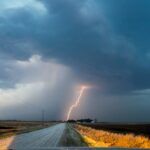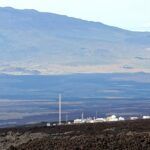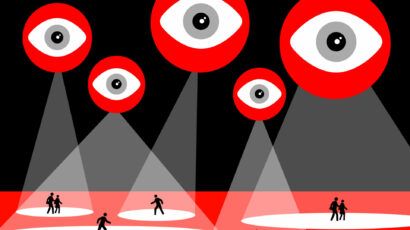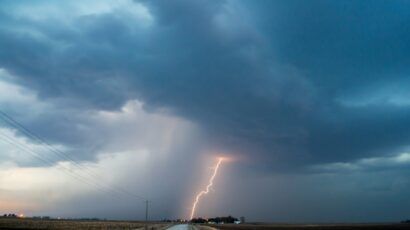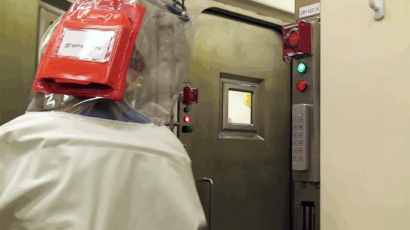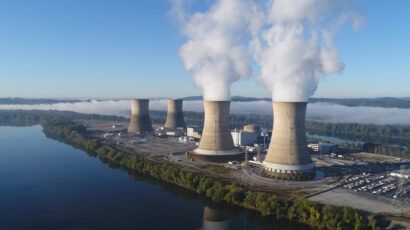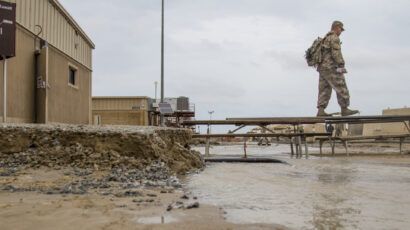Climate MADness
By Dawn Stover | June 20, 2012
In The Butter Battle Book by Dr. Seuss, the Yooks and the Zooks go to war over whether bread should be eaten with the buttered side up or down. The battle escalates from slingshots to guns to goo-spewing war machines, and eventually both the Yooks and the Zooks acquire a tiny but extremely destructive bomb called the Bitsy Big-Boy Boomeroo. Neither side has any defense against the bomb, and both sides are left wondering who will drop it first.
A parable of the arms race, the book was banned from some libraries during the Cold War, but it nicely illustrates a conventional military doctrine that is so simple and intuitive even a child can understand it: mutually assured destruction, or MAD. Surely no society, not even the crazy Zooks who butter their bread on the bottom, would launch a full-scale weapons exchange guaranteed to annihilate its own citizens along with their enemies. The security of every American rests on that assumption.
But when it comes to climate change, the logic of mutually assured destruction seems to have escaped the politicians in Washington and the diplomats in Copenhagen (for an utterly Seussian take on the Copenhagen talks, click here) and Cancun and Durban and Bonn. They fail to recognize that MAD does not require the detonation of massively powerful nuclear bombs. Americans and our economic rivals can destroy the planet more slowly, but just as surely, by launching bitsy boomeroos of carbon dioxide and methane, of nitrous oxide and hexafluoroethane — day after day, year after year — until eventually we have ruined our water supplies, agriculture, power and transportation systems, natural environment, and even our own health and safety. Until one day, we have converted large swaths of our planet into dead zones. This is the MADness of climate change.
Critics sometimes shake their heads over the Bulletin‘s decision to take climate change into account when setting the Doomsday Clock. They argue that climate change can’t annihilate civilization in a blitz of mushroom clouds. True, but if we don’t make some radical changes in short order, climate change will end life as we know it. It will just take a little longer. (The Bulletin examines all manner of existential threats, not just the expedient ones.)
Because of climate change, some coastal villages and small island nations are already disappearing under rising seas. And don’t think that, just because you live in the heartland, you and your descendants are safe: Researchers at Purdue University and the University of New South Wales in Australia have calculated that, if average global temperatures were to increase by about 7 degrees Celsius (which is conceivable within this century, in the absence of strong mitigation measures), humans in some regions would no longer be able to dissipate body heat quickly enough to survive. With warming of 11 to 12 degrees Celsius — entirely possible if emissions continue — most of the places where humans now live would become uninhabitable.
Carbon equity — allowing countries such as China and India to pollute to the same level as industrialized nations — is “the logic of mutually assured destruction,” said British environment writer Mark Lynas, an unpaid adviser to the island nation of the Maldives, in an interview. And, if the United States refuses to make significant reductions in emissions unless China and India do, we’ll all keep driving toward each other at high speed on a dark road, playing a very dangerous game of chicken.
It’s strange that so many politicians today can’t see the connection between nuclear war and climate catastrophe. Scientists long ago realized that a full-scale nuclear exchange would wreak havoc not just through bomb damage and radiation, but also by altering the climate. This realization played a major role in the Cold War endgame, when both the United States and the Soviet Union understood that a nuclear war would destroy agriculture and ecosystems over vast areas. As former Soviet leader Mikhail Gorbachev explained in an interview with Salon in 2000: “Models made by Russian and American scientists showed that a nuclear war would result in a nuclear winter that would be extremely destructive to all life on Earth; the knowledge of that was a great stimulus to us, to people of honor and morality, to act in that situation.”
The Energy Department national labs built to create nuclear weapons are now doing some of the best research on how to understand and mitigate climate change. Scientists there know what a climate bomb can do. But today their warnings go unheeded, and the carbon superpowers have not put a stop to the madness. People do not fear climate change the way they fear nuclear war because nobody has his or her finger on the big red button. Instead it’s billions of people pushing smaller buttons all the time, again and again and again. Until it’s too late to stop.
If only the problem of environmental destruction were as simple as Dr. Seuss made it out to be in another great book, The Lorax, which has been called “a kind of Silent Spring for the playground set” and was recently released as a 3-D feature film. The Lorax is about what happens when resources are consumed faster than they are replenished, species go extinct, and air pollution threatens a once-verdant world. But few readers or moviegoers see The Lorax as a tale of mutually assured destruction or even as about themselves. No, most of us just love the Seussian whimsy that makes this film so fun for kids — kids who have been loaded into the SUV and driven to an air-conditioned theater in the mall to guzzle high-fructose corn syrup from giant plastic cups. (Mazda is even selling a “Seuss-ified” SUV, and IHOP is offering Truffula Chip Pancakes with rainbow sprinkles.) As though, instead of a parable about life on planet Earth, the message of The Lorax were: This isn’t about you, kids and moms and dads. This is about the greedy Once-ler. And if things get really bad, you can always plant a truffula tree!
Despite its prominence in both the book and the film, Dr. Seuss’s true message seems to have gotten lost among the neon-colored, computer-generated trees: “Unless someone like you cares a whole awful lot, nothing is going to get better. It’s not.”
Together, we make the world safer.
The Bulletin elevates expert voices above the noise. But as an independent nonprofit organization, our operations depend on the support of readers like you. Help us continue to deliver quality journalism that holds leaders accountable. Your support of our work at any level is important. In return, we promise our coverage will be understandable, influential, vigilant, solution-oriented, and fair-minded. Together we can make a difference.
Topics: Climate Change, Columnists


